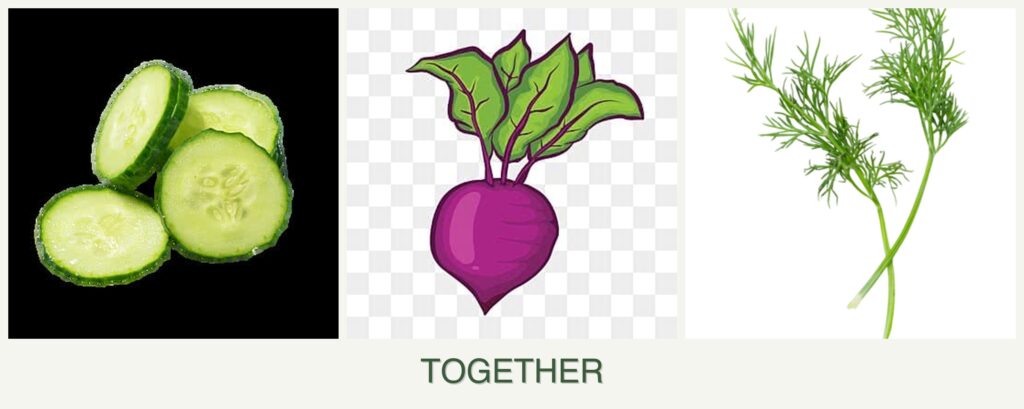
Can you plant cucumbers, beets and dill together?
Can You Plant Cucumbers, Beets, and Dill Together?
Companion planting is a popular gardening technique that involves growing different plants together to enhance growth, deter pests, and maximize space. Many gardeners wonder about the compatibility of cucumbers, beets, and dill. In this article, we’ll explore whether these plants can thrive together and provide practical tips for successful companion planting.
Compatibility Analysis
Yes, you can plant cucumbers, beets, and dill together! These plants complement each other well, making them excellent companions in the garden. Cucumbers benefit from the pest-repelling properties of dill, while beets offer a low-growing option that doesn’t compete for sunlight. Dill attracts beneficial insects that help control pests, creating a harmonious environment for all three plants.
Key factors to consider include their growth requirements, pest control benefits, and nutrient needs. Cucumbers and dill both prefer full sun, while beets can tolerate partial shade, allowing for flexible garden placement. Additionally, dill’s ability to attract pollinators and predatory insects helps reduce pest pressure on cucumbers, promoting healthier growth.
Growing Requirements Comparison Table
| Plant | Sunlight Needs | Water Requirements | Soil pH & Type | Hardiness Zones | Spacing Requirements | Growth Habit |
|---|---|---|---|---|---|---|
| Cucumbers | Full sun | Moderate | 6.0-7.0, well-drained | 4-12 | 12-18 inches apart | Vining, needs support |
| Beets | Full sun/Partial shade | Moderate | 6.0-7.5, loamy | 2-10 | 2-4 inches apart | Root crop, low-growing |
| Dill | Full sun | Low to moderate | 5.5-6.5, well-drained | 3-11 | 12-18 inches apart | Upright, 2-3 feet tall |
Benefits of Planting Together
Planting cucumbers, beets, and dill together offers several advantages:
- Pest Repellent Properties: Dill attracts beneficial insects like ladybugs and wasps, which prey on pests such as aphids that can harm cucumbers.
- Improved Flavor: Some gardeners believe that dill enhances the flavor of cucumbers.
- Space Efficiency: Beets’ low-growing habit allows them to fit beneath taller cucumber plants, optimizing garden space.
- Soil Health Benefits: The diverse root structures of these plants help improve soil aeration and nutrient distribution.
- Pollinator Attraction: Dill’s flowers attract pollinators, boosting cucumber yields.
Potential Challenges
While these plants can coexist, there are challenges to consider:
- Competition for Resources: Ensure adequate spacing to prevent overcrowding and competition for sunlight and nutrients.
- Watering Needs: Cucumbers require more water than dill, so monitor soil moisture levels carefully.
- Disease Susceptibility: Cucumbers are prone to powdery mildew, which can spread if not managed properly.
- Harvesting Considerations: Be mindful of dill’s height when harvesting to avoid damaging cucumber vines.
Practical Solutions
- Use mulch to retain soil moisture and reduce competition.
- Plant in raised beds to improve drainage and disease prevention.
- Regularly prune dill to prevent overshadowing cucumbers.
Planting Tips & Best Practices
- Optimal Spacing: Space cucumbers and dill 12-18 inches apart, with beets 2-4 inches apart beneath the canopy.
- Timing: Plant in spring after the last frost when soil temperatures reach 60°F (15°C).
- Container vs. Garden Bed: While suitable for garden beds, cucumbers and dill can also thrive in large containers with proper support.
- Soil Preparation: Amend soil with compost for improved fertility and drainage.
- Companion Plants: Consider adding marigolds or nasturtiums to further deter pests.
FAQ Section
Can you plant cucumbers and dill in the same pot?
Yes, but ensure the pot is large enough to accommodate their growth and provide support for cucumbers.
How far apart should cucumbers and beets be planted?
Cucumbers should be spaced 12-18 inches apart, with beets 2-4 inches apart beneath them.
Do cucumbers and dill need the same amount of water?
No, cucumbers need more water than dill, so adjust watering accordingly.
What should not be planted with cucumbers, beets, or dill?
Avoid planting cucumbers near potatoes, and keep dill away from carrots to prevent competition.
Will dill affect the taste of cucumbers?
Some gardeners believe dill enhances cucumber flavor, but this is subjective.
When is the best time to plant cucumbers, beets, and dill together?
Plant them in spring after the last frost, when soil temperatures are consistently warm.
In conclusion, cucumbers, beets, and dill can coexist harmoniously in the garden, offering mutual benefits and enhancing your vegetable garden’s productivity. With careful planning and attention to their needs, you can enjoy a bountiful harvest.



Leave a Reply